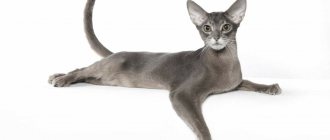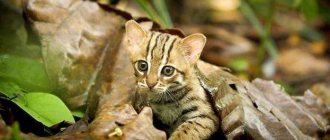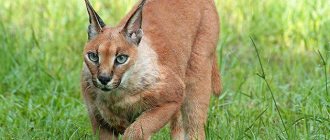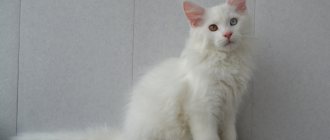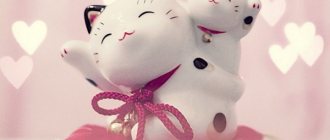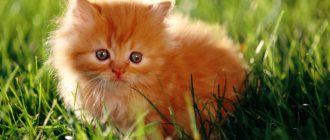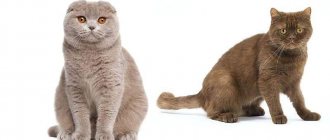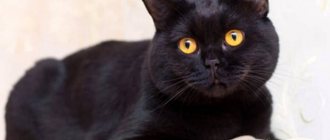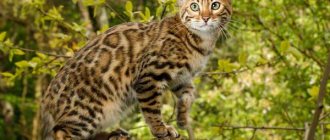Color classification
The color of Bengal cats is an essential part of the official breed standard, and therefore is strictly regulated. After birth, each kitten is assigned an alphanumeric value corresponding to the shade of its fur.
The color of Bengals is determined very accurately by number:
- At the beginning of the code there is an indication of the breed, consisting of 3 capital letters of the English alphabet. The designation BEN corresponds to Bengal.
- The following is the name of the base of 1 or 2 small Latin letters:
- n – black;
- ns – silver black;
- ny – golden black.
- At the end there is a numerical value that describes the picture and background more accurately.
- 22 – marble;
- 24 – spotted or rosette;
- 31 – sepia;
- 32 – minx;
- 33 – links.
In addition, there are colors that do not have their own code, since they are not recognized by the international cat association:
- carbonic;
- melanistic;
- blue.
Genetic similarities and differences between silver-colored Bengals and classic red ones
The silver coloring of a Bengal cat is ensured by the presence of the corresponding inhibitor gene “i”, which the Bengal cat received from other breeds during crossing. The fur of the body is painted with stripes of gray-white or gray-smoky pearl color. Darkening is allowed on the back, but only slightly. The inside of the paws and belly are lightened approximately two to three tones from the main color of the body. Like a brownie, the eyes, nose, and lips have a contrasting outline. Other standards are:
- paw pads are chocolate brown, almost black, or coal black;
- tip of the nose from pink and red to bright brick color;
— the color of the iris is allowed in yellow-golden, emerald-green shades; occasionally, as a result of mutations, representatives of the breed subspecies have blue eyes.
An integral factor in belonging to the breed is the presence of spots on the belly. The inclusion of silver bengals in the snow clan, which is allowed by some clubs and even federations, is not entirely legal, since the silver type should not show brown color and various rufisms.
Types of drawings
During breeding of the breed, preference is given to an appearance close to the wild one.
The Bengal cat most closely resembles its ancestors precisely in the pattern on its coat, which is divided into 2 types:
- marble;
- rosette or stain.
The marble pattern is the brightest and most saturated. The color of the pattern is the same throughout the body, usually quite dark and not washed out. Bengal cats in marbled color are the most common and less valued than other species.
Spot and rosette have the same meaning in the Bengal code. At the same time, the pattern on the body is different, which is clearly visible in the photo.
Rosettes are slightly stretched, full or open rings that can be regular or irregular in shape, but never merge together. This color makes Bengal cats look like a leopard or snow leopard. A pattern of rosettes of similar sizes, located evenly over the entire surface of the wool, is valued more highly.
Names and varieties of colors
Links color
The external characteristics of such a mustache are almost identical to the snow leopard.
The color of this Bengal resembles a snow leopard, since the main tone is white-cream, and the large rounded spots are light brown or chestnut. The peculiarity of the color is the contrast of the pattern, but the difference between the shade of the fur tone and the patterns should be small. Snowy Bengal kittens, called Lynx, appear with snow-white fur and the full development of color lasts 1 year. Representatives of this color have a dark brown nose, pads, lips and eyeliner.
Sepia color
This cat color is characterized by a darker background - dark cream or ivory. The lines of the pattern are rosette spots with the presence of dark brown rings on the tail, almost black in color. In the sepia color, the difference in color shades between the spots and the main tone is practically absent or minimal. However, the pattern should not merge or be blurred. Like Lynx cats, the markings on the face are dark and the pads of the paws indicate pink skin. The color of the eye irises is rich yellow or green.
Mink shade
The basis of this color is a delicate cream shade, on which the main pattern is clearly visible.
Such kittens are born with a clear pattern on their marbled fur coat. In adult individuals, the main tone of the fur is golden or cream, the pattern is contrasting, clearly defined, the spots are elongated, brown, dark red, gray or golden. There are characteristic markings on the muzzle, like representatives of this color group. Irises are aqua or green. The tail can be a single dark shade.
Bengal colors
Despite the wide variety of patterns, the Bengal breed does not have many color options. Strict selection has created 3 background coat colors:
- gold or brown;
- silver;
- snow.
Gold is the most common color of the Bengal breed. The animal's eyes are green or yellow, its paw pads are brown. The palette includes many shades of wool:
- light beige;
- yellow-brown;
- bronze;
- golden red;
- chocolate;
- chestnut;
- reddish brick;
- dark brown.
Silver in the palette of Bengal cats represents a cold steel-gray shade. On a silver base, the black pattern is especially clearly visible. The undercoat is colored white or grayish, the same color is found on the belly and the inside of the legs. The paws and tip of the tail are black, while the nose is a brick shade. Silver cats have green or yellow eyes.
The snow color of the Bengal breed is the rarest. Despite the cold name, the light tone is warmer, unlike silver. The animal's fur is white with a milky or coffee pattern. Snow Bengal is more diverse in palette and is further divided into types.
The color of the true color is hidden at the birth of the kitten under the baby's gray fur, which falls out and is replaced by permanent hair as it grows up. The real appearance of a Bengal cat is determined closer to the year of life.
Marble
Marbled Bengals are the most common within the breed. To obtain a high-quality pattern on the coat, you need to choose the right parents, since the combination of stripes is inherited.
Bengal standard
During the formation and development of the breed, the main emphasis was placed on the external resemblance of Bengals to their wild ancestors, but at the same time, Bengals should have the friendly character of a domestic cat. Any description of the appearance of a Bengal cat creates the image of a wild forest predator. These are quite muscular cats, strong, with strong bones, distinguished by good health and endurance. Everything about them marks them as excellent hunters, capable of patiently tracking down prey, jumping high and nimbly climbing trees. The body of Bengals is elongated, the hind legs are slightly higher than the front. The paws are large, the claws are retracted to silently sneak up on prey. A cat can sit for a long time, frozen, waiting for the moment. And even a slight movement of the tail does not reveal its presence. A small, beautiful head on a strong, muscular neck. The eyes are expressive, large, almond-shaped. When they stalk their prey, they have the cold eyes of a killer, slightly narrowed. Sometimes a strange primitive melancholy suddenly appears in their gaze, as if the forest and field, their distant homeland, are calling them. The nose is large, wide, with a convex nasal mirror. The ears are short, with a wide base and rounded tips, set wide and slightly tilted forward, as if on guard. Bengals have high cheekbones, a strong chin, and wide, pronounced whiskers. But what is most impressive is the luxurious, thick and soft wool, which feels reminiscent of natural silk to the touch. The colorful, bright coat is decorated with contrasting spots on a warm, sandy to reddish-brown background. One of the hallmarks of Bengal cats' coat quality is "glitter," usually found on clean, unticked coats. Bengals naturally have a special coat structure that refracts light quite interestingly. This may be due to the presence of tiny voids in the hairs. The above-mentioned effect is not shine, not sparkle, but radiance. When you look at a cat, you get the impression that thin, thin rays of light are passing through the fur, and it begins to shine. This distinctive quality is a desirable addition to the breed. Drawings
Patterns on the body can be of 2 types: spotted - spotted and marbled - marbled. There are also general requirements. Preference is given to spots and stains that are more contrasting, with clear, sharp outlines. Contrast is created by two, and sometimes three or more, colors and shades. On a light background, large rosettes or lines of marble color are shaded with a third color from the main background, and the patterns turn out to be even more whimsical. Nature has applied “makeup” to the bengal’s face: bleached fur around the eyes, so-called “glasses”, ideally almost white chin and chin. The letter “M” on the forehead turns into an exquisite hieroglyph in the form of a beetle. On the throat there are continuous or torn “necklaces” of spots. The lips, eyelids and nose are outlined in a dark outline of black or brown and the same pads are in accordance with the main color of the coat. The neck, chest, belly, and inside of the paws are much lighter than the fur on the sides and back; ideally, an almost white belly and inside of the paws are desirable; this is a feature characteristic of wild Asian leopard cats. In this case, the belly, legs and tail are covered with small round or elongated spots. Light and dark spots alternating along the length of the tail can be closed in rings; the end of the tail is always black or dark brown, depending on the color. Wild Asian leopard cats wear spotted coats. Small spots of a round or triangular shape are located on the body randomly or in horizontal rows. We can observe the same pattern in domestic Bengals, this pattern is called spotted. But sometimes the skins of forest animals were painted with a more complex pattern, consisting of triangles, commas, and curved stripes. By combining the genes of wild and domestic cats with targeted selection, unusually interesting variants are obtained, and then beautiful rosettes appear on the skins instead of simple spots. Rosettes come in the form of rings and half-rings, and can resemble a paw print, a dart tip, or a bunch of grapes. Large individual round spots of solid color are also called rosettes. Preference is given to patterns made up of spots of the same type, located evenly and isolated from each other. It is important that they do not merge into vertical “tiger” stripes. This is a drawback. Large sockets should also not flow into one another. From the shoulders to the tail along the ridge there are rows of spots of a round shape or in the form of curved stripes. The name of another pattern, marbled, speaks for itself. Twisted, flowing horizontal lines and fancy patterns are very reminiscent of noble marble. But beautiful round spots and concentric circles around them, such as other domestic cats have and are called “bull’s eye” by Americans, are not allowed. The same applies to “tiger” stripes. Many Bengal kittens go through a stage of fuzzyuglies development as they grow older. Bright and contrasting at three weeks of age, kittens at four to five weeks are overgrown with ticked baby fur, the main background fades, and the spots fade. This is due to a genetic program that helps protect young Asian leopard cats from possible dangers in the jungle! The coat again begins to “clean up” and acquire contrast after 12 weeks and again becomes bright again by 6 - 7 months, the final color is established by a year, and sometimes later. Colors of Bengals The classic color of Bengals is brown spotted tabby. There are also, and less common, silver spotted (blacksilverspottedtabby), “snow” colors (seal spotted). Brown spotted tabby: Bengals of this color are the most spectacular and the most numerous. Spots and patterns range from brown or dark brown to black, on a lighter base background. The main background of the coat can vary from light beige and golden sand to reddish brown. The tip of the tail is always black or dark brown, depending on the color. The standards give preference to bright, saturated tones of yellow and gold. Paw pads, eye rims, nose and lips should be black. The nose is brick-colored. Eye color can be gold, copper, green, bronze, brown or hazel. Black silver spotted tabby: The main color is pure silver-white, the undercoat is white. Black spots and patterns. The outline of the nose, eyes and lips are black. The paw pads are jet-black or black-brown. Eye color ranges from golden to emerald green, with rich, deep tones preferred. BREED STANDARD in the TICA BENGAL (BG) system. Show scale of points HEAD. . . . . . . . . . . . . 35 points Form. . . . . . . . . . . . . . . 6 Ears. . . . . . . . . . . . . . . . . 6 Eyes. . . . . . . . . . . . . . . . 5 Chin. . . . . . . . . . 3 Muzzle. . . . . . . . . . . . . . . 4 Nose. . . . . . . . . . . . . . . . . .2 Profile. . . . . . . . . . . . . .6 Neck. . . . . . . . . . . . . . . . . 3 BODY. . . . . . . . . . . . . . . 30 points Corpus. . . . . . . . . . . . . . . 5 Paws. . . . . . . . . . . . . . . . 4 Feet. . . . . . . . . . . . . . . 4 Tail. . . . . . . . . . . .. . . . 5 Backbone. . . . . . . . . . . . . . 6 Musculature. . . . . . . . . 6 WOOL / COLOR / PATTERN ...... 35 points Texture . . . . . . . . . . . . . 10 Figure. . . . . . . . . . . . . . 15 Color. . . . . . . . . . . . . . . . 10 CATEGORIES: All. DIVISIONS: Tabby, Silver/Smoke. COLORS: only BrownTabby, SealSepiaTabby, SealMinkTabby, SealLynxPoint, BlackSilverTabby, SealSilverSepiaTabby, SealSilverMinkTabby, SealSilverLynxPoint. The pattern is only spotted or marbled. ALLOWED CROSSINGS: No. HEAD Shape: Wide modified wedge with rounded contours. More elongated than wide. In relation to the body it is relatively small, but proportional. The skull, slightly convex behind the ears, meets the neck in a smooth curve. The jaws of adult cats are powerful. In general, the head should be as different as possible from that of a domestic cat. Ears: Medium to small, rather short with a wide base and rounded tips. Standing as wide as possible; the lines of the ears continue the contour of the muzzle when viewed from the front, and are directed slightly forward when viewed from the side. Small horizontal “brushes” on the inside are acceptable, but lynx tassels on the tips are undesirable. Eyes: Oval, almost round. Large, but not excessively so. Set wide apart, set fairly deep and slightly oblique to the base of the ears. Eye color does not depend on coat color with the exception of lynx points. The brighter and more saturated it is, the better. Chin: Strong, in line with the tip of the nose. Muzzle: Full and wide with large, prominent whisker pads, high, pronounced cheekbones and small hollows underneath. Nose: Large and wide with a slightly puffy nose. Profile: The profile line from the forehead to the bridge of the nose flows without a sharp bend. The bridge of the nose is located just above eye level. A slightly concave, almost straight line stretches from it to the tip of the nose. Neck: Long, strong, muscular, in proportion to the head and body. BODY Body: Powerful and elongated, but not like that of Orientals or other eastern type cats. Medium to large in size (but not as large as the largest domestic breeds.) Feet: Medium length, hind legs slightly longer than front. Soles: Large, rounded, with prominent toe joints. Tail: Medium length, thick, tapering towards the end, with a rounded tip. Bones: Strong and solid, not subtle in any way. Muscles: Very powerful, especially in cats - one of the most characteristic features. COAT / COLOR / PATTERN Length: Shorter than average. In kittens, slightly longer hair is acceptable. Texture: Dense and thick, adjacent to the body, extremely soft and silky to the touch. Pattern: Spotted or marbled. Spotted The arrangement of spots is random or horizontally directed. Rosettes showing two different colors or shades and shaped like a paw print, dart tip, donut or half donut, or cluster-shaped are preferred over single spots but are required. The contrast with the background should be maximum, giving a clear picture with sharp outlines. It is desirable that the “necklace” and camouflage markings are pronounced and clear. If possible, white belly and undersides of the body are desirable. A spotted horizontal stripe pattern on the shoulders and a spotted or rosette tail are welcome. Spots on the belly are required. Marbled See TICA Uniform Color Description (74.1.1.2.1.) COLOR : All variations of brown are allowed. The color of the pattern is in a brown-black range. Light rim - “glasses” around the eyes and possibly a whiter shade of whisker pads, chin, neck, belly and inside paws are desirable.SealSepiaTabby, SealMinkTabby, andSealLynxPointTabby: Pattern of brown, various shades.There should be minimal or no difference between the color of the body spots (the actual pattern) and the color of the markings. BASIC DESCRIPTION The goal of the Bengal Breed Program is to create a domestic cat that has the physical attributes of the small cats found in the wild, but with the affectionate nature of the domestic cat.With this goal in mind, judges must place special emphasis on these appearance characteristics of Bengals that distinguish them from other purebred domestic cats.The Bengal cat is an athletic animal, instantly responsive to everything that surrounds it, friendly, curious, confident, strong, agile, balanced and graceful. This cat is medium to large in size and appears very muscular and robust. A wide nose, convex whisker pads, large oval, almost round eyes with a relatively small head give it the appearance and gaze of a nocturnal forest predator. Its slightly concave, almost straight, profile and relatively short ears with a wide base and rounded tips add to the characteristically unique appearance of the Bengal. The short, dense coat is uniquely soft and silky to the touch. The wool can have a sheen effect or not, without preference. A thick, medium-length tail that is carried low makes this cat even more harmonious. ASSUMPTIONS Smaller size (while maintaining proportions) in cats. Kittens have slightly longer fur. "Cheekiness" of adult cats. Slightly almond shaped eyes. Grayish undercoat. The color of the paw pads is not consistent with the accepted color. DISADVANTAGES In spotted cats: vertical stripes formed by fused spots and characteristic of a mackerel (tiger) pattern. For marble ones: “bull’s eye” - design elements in the shape of a circle. SealSepia, SealMink and SealLynxPoint cats have noticeably darker color markings (compared to the color of the body pattern). Any distinct white “medallion” patches on the neck, chest, belly or anywhere else. DISQUALIFYING FAULTS Absence of a pattern on the abdomen. And also: The character of a Bengal cat should not be aggressive. Any manifestations of aggression will result in disqualification. The cat may be timid, may struggle and try to escape or meow loudly, but it should not pose a threat. In accordance with the Show Rules, paragraph 16, the following shall be disqualified: o cats that bite (216.9), o cats that clearly show intent to attack (216.10), o cats with testicles not descended into the scrotum (216.11), o cats that the tail or part thereof is missing, with the exception of the list of cases permitted by the Board for Approval of the Breed Standard (216.12.1), o cats with more than five toes on the front legs and more than four on the hind legs, except in cases where this was the result of injury or permitted by the Board according to the Approval of the Breed Standard (216.12.2), o visible or invisible tail defects, if the Standard approved by the Board requires disqualification, strabismus, complete blindness, excessively small size inappropriate for the breed, (216.16.9), flattened sternum or underdevelopment of the chest ( 216.12.11.1) Breed standard in the WCF system Grading scale Body ………………………………30 Head ……………………………..20 Eyes …………………………… …. 10 Coat texture ………… 10 Color and pattern ………….. 25 Condition ………………….. 5 Body: Medium to large, muscular, elongated, strong. The limbs are of medium length, strong and muscular. The paws are large and round. The tail is medium length, thick, with a rounded tip. Head: Massive skull, slightly longer than wide, with rounded contours and a powerful, wide muzzle.
Profile with an easy transition. The neck is long and powerful. Chin: Strong Ears: Small to medium in size, slightly slanted forward, with rounded tips and a patch of wild color. Eyes: Large, oval. Set wide, at a slight angle. Any color is acceptable, except blue and aquamarine; for the snow bengal (seal lynx) - only pure intense blue. Coat: Short, thick, shiny, silky (like fur). Color: Distinct, contrasting black or brown pattern, spotted or special marbled, on a golden-orange background. Snow Bengal (Seal Links) is a colorpoint. The points have the same color as the Bengal. The body is somewhat lighter, but, unlike other colorpoints, it has a shade and pattern that matches the color of the points. To non-specialists, the Snow Bengal is not similar to the Colorpoint. Description of the pattern is in the list of colors. The following colors are recognized: Brown tabby spotted, brown tabby marbled, seal sepia spotted, seal sepia marbled, seal mink spotted, seal mink marbled, seal linkspoint spotted and seal linkspoint marbled.
Unrecognized colors
In addition to the standard color of Bengals, there are new options that have not yet received recognition:
- Carbonic. The type resembles silver, but the base tone is much darker. The clearly defined black pattern has no blur and is clearly visible against a gray or ashy background. The general color palette is cold. The nose of the Charcoal Bengal is black, and there is a light edging around the eyes.
- Melanistic. The almost monochromatic black Bengal cat with a faintly visible pattern belongs to this color. A kitten is born with a normal contrasting pattern, which with age completely covers up the glitter. Occasionally, melanistic Bengals may be a different color.
- Blue. This color option is characterized by a less bright pattern of bluish-gray color with a metallic sheen. The pattern consists of large rosettes or spots. The background of the coat is bluish-gray on the back and soft peach on the belly. The Blue Bengal cat is extremely rare.
The rarest colors
Blue and black bengals are not yet recognized by the International Feline Association, but due to their interesting colors, they are popular.
Melanistic
This is a black Bengal with a subtle pattern. Panthers wear coats of this color in nature. A newborn kitten has a standard patterned color, and the darkening of the fur of a melanistic Bengal is observed in adulthood.
Charcoal color
A black Bengal cat can be confused with a silver cat, but the former has a darker color background: rich gray or ash. The design is black, clearly visible against the background color. The color of the charcoal bengal should be called cold. The lobe is black, and the eyes are edged with light fur.
Blue
The blue bengal, similar in color to the snow leopard, is a rarity. The Blue Bengal cat has a bluish-gray fur with a steel tint, a spotted or rosette pattern, less pronounced than other varieties. The spots are blue-gray. On the belly the background color is lighter and has a pale cream tint.
Snow
Rare, but sought after and extremely beautiful colors. The coat is light, coffee-white. The tail and paws at the end are deep brown or black.
There are three types of colors of the snow Bengal cat:
- Bengal linx variety is a delicate, light cream type of color that appears in the presence of a recessive point color gene. A newborn kitten is white or has a subtle pattern. The background color and pattern darken as the animal matures. The muzzle, ears, and limbs first become darker, and the pattern appears only a few months after birth. The irises of the eyes are exclusively blue, the nose is brownish-pink.
- Snow Bengal Minx is a cream color with a milk chocolate pattern, due to inheritance from Siamese and Burmese ancestors. A newborn kitten has a pale beige background coat color, and the pattern is almost invisible. The pattern becomes richer as the animal matures. The iris is often blue and green, less often yellow. The lobe is brownish-pink.
- Snow Bengals of the sepia variety, distinguished by a rich cream background coat color with a chocolate pattern, are obtained by inheriting the Burmese gene from their parents. Visually, it seems that the cat belongs to the golden-brown variety, but upon closer inspection it is noticeable that the coat is lighter and does not have a golden sheen. In a newborn kitten, the light chocolate pattern is clearly visible. The iris is only green or yellow-brown. The nose is reddish brown.
Other
There are Bengals of other original colors:
- solid black;
- solid chocolate;
- lilac;
- tortoiseshells.
But Bengal cats with such colors are rare and are considered defective: they have no exhibition value and are not used in breeding.
Phasing in Bengal kittens
The spectacular color characteristic of Bengals does not appear immediately after birth. The pattern on a kitten's fur is unknown even at the time of moving to a new home. The babies are covered with thin hairs of a white, gray or red hue with a non-distinctive pattern. Up to a year, a Bengal cat can resemble a simple yard striper.
The phasing effect confuses buyers, because at the time of purchase the main qualities of the breed are hidden and you can only trust the reputation of the breeder.
The kitten's bright appearance is hidden due to phasing, which serves as a natural camouflage. The baby's coat begins to change at the age of 12-15 weeks, and ends no earlier than 7 months. The lighter the background of the coat, the sooner the camouflage disappears, while dark merle colors appear slowly. However, watching your pet grow brings pleasure, as the Bengal is transforming every day. By the age of 2, the beauty of a purebred Bengal cat is fully revealed.
Among the colors of the Bengal you can find both bright patterns and restrained tones. The diversity of the wild palette, combined with some unpredictability, makes the Bengal cat breed attractive to lovers of natural beauty.
What is “Fuzzy” in Silver Bengal kittens?
The term, translated from English either as “ugly” or as “vague or shaded,” explains the essence of the breed’s unusual natural tendency to camouflage spots. In light-colored kittens it is less pronounced than in brownie offspring. By about a month, the offspring sprout long, thin hairs designed to hide the bright markings from the eyes of predators in the Asian jungle. After a couple of months, phasing comes to an end - the Bengal kitten loses its “extra” fur, revealing a wonderfully beautiful pattern. All Bengal kittens are subject to the process, no matter how far they are from the ancestry of their forest ancestors.
The unusual silver of Bengal cats of this type of color fascinates with the contrasting patterns of their fur coat. Of course, the silver spotted variety is more similar to a snow mini-leopard, especially spotted-rosets, which determines the popularity of the “rosette on silver” color among lovers of elite cats of an elite young breed. However, marble ones also have many fans. Marble, when he stretches out, showing off his intricate patterns, is truly amazing.
